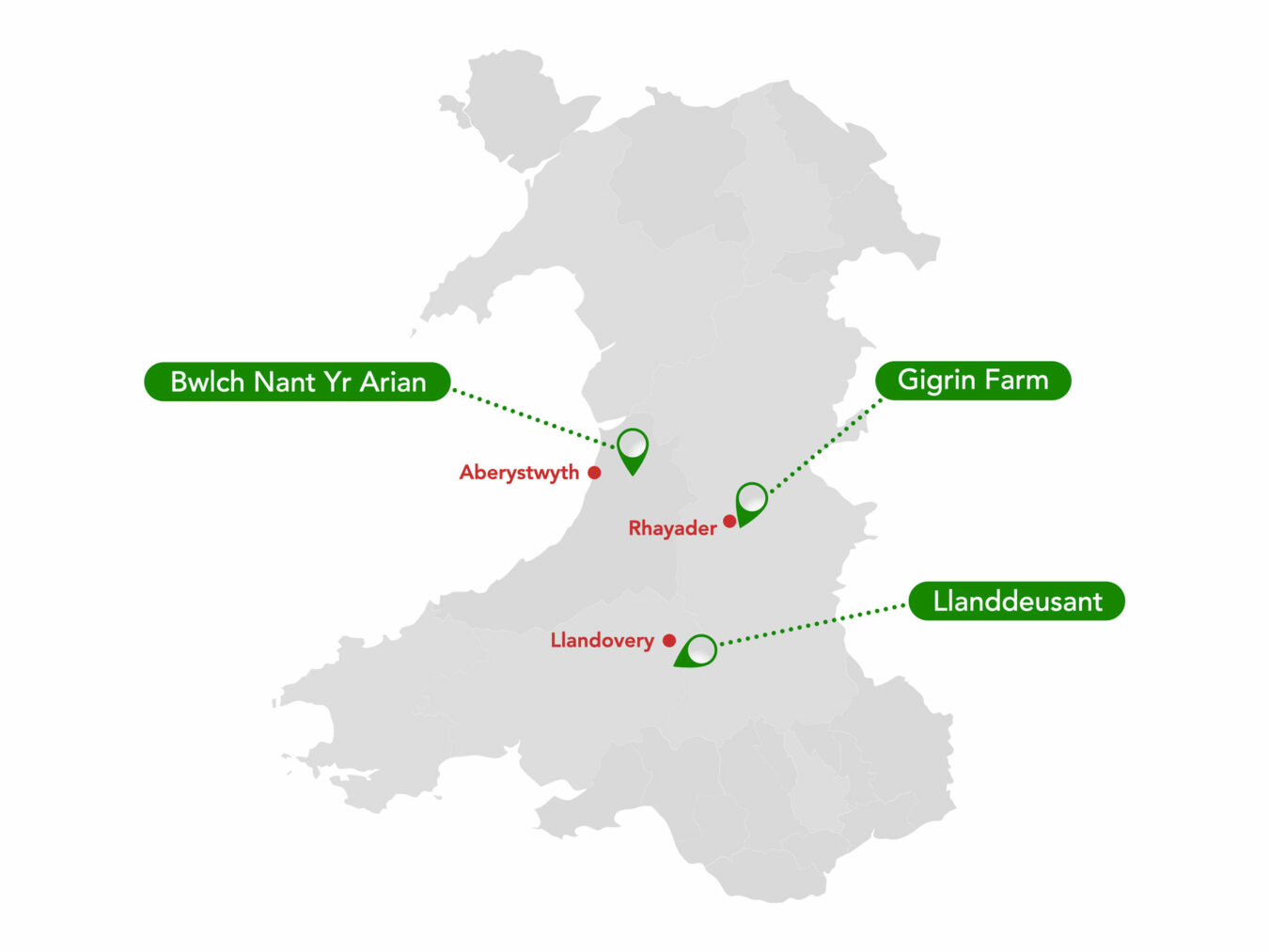Wales offers an array of opportunities for wildlife enthusiasts and photographers alike. Among its charismatic avian inhabitants, the red kite (Milvus milvus), with its reddish-brown plumage, angled wings, and distinctive forked tail, stands out as one of the most iconic and captivating species to observe in the Welsh wilderness.
In this article, I will guide you through the three best locations in Wales where red kites can be observed and photographed. These locations are feeding stations where food is provided to the kites daily, offering visitors a thrilling spectacle to watch, and photographers a great opportunity to capture the birds up close. You will find all the information you need about the kites, the locations, and the best times to visit, as well as tips and tricks to make the most of your day.
Gigrin Farm
Gigrin Farm is a family-run farm located just outside Rhayader, Mid-Wales. It is the best-known site to see and photograph red kites in Wales, having been featured on nature TV specials on several occasions. It is also the first official feeding station, opening to the public in late 1992 following a proposal from the RSPB (Royal Society for the Protection of Birds), who had witnessed the farm owner, Mr Powell, feeding kites himself.

You can observe the red kites from a distance on the viewing field, or get closer to the action in one of the five public hides available. There are also four specialist photographic hides that let you be higher up or very low on the ground.

There is ample parking at the farm, with an adjacent large field available when the default parking zones become full. The staff are very friendly, and the site includes refreshments, picnic tables, toilets, and a souvenir shop. The coffee shop offers a selection of homemade cakes, snacks, drinks, and ice cream. Indoor seating is also available.
You need to pay to enter, and I highly recommend booking in advance on the Gigrin Farm website, as there is a maximum number of visitors allowed per day, and it’s a very popular location during holiday seasons. Booking in advance will also allow you to double-check when the farm is closed, as it is not open every day of the week, except in August and during school holidays.



What you will see at Gigrin Farm
There can be as many as 300 red kites, and the number can double during the winter! You may also see a rare leucistic white-coloured red kite. Crows and ravens will be the first to show up around the feeding area and will be the first to go onto the field, signalling the kites to go on the offensive and dive down. There are usually a few buzzards as well, which are more vocal than the kites.
Before the feeding starts, or when the kites take a break, smaller birds such as white wagtails come to the field. Additionally, a black and white cat (one of many cats you’ll see at the farm) may sneak in to grab a piece of meat if it gets the chance.

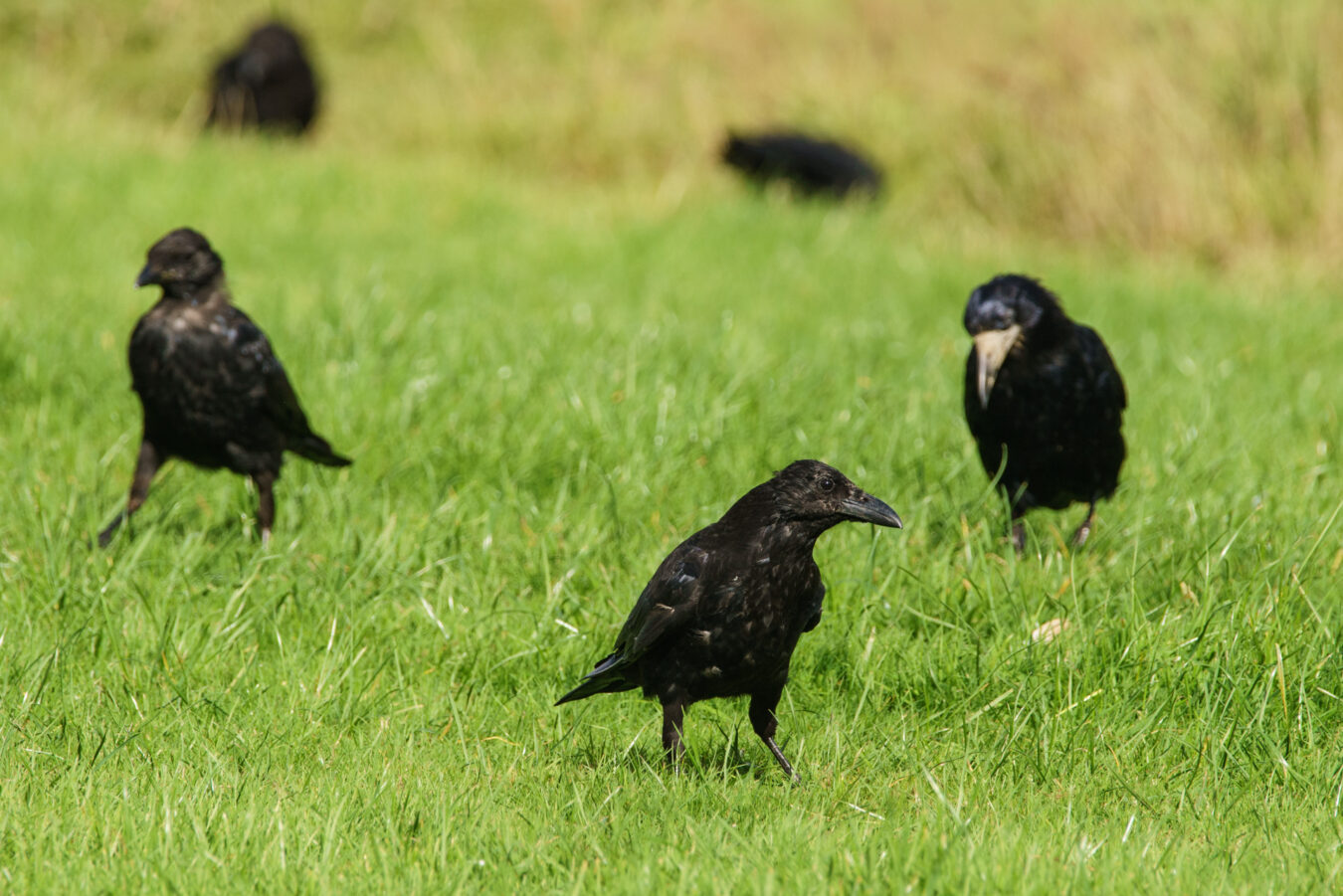


The Photographers’ Corner
The photographic hides are not inexpensive, but they are definitely worth the price: you will have more space and the best views. You can also take pictures from the public hides or the viewing field if you prefer, although you’ll be a bit too far on the latter.
In the hides, you are very close to the field, so you don’t necessarily need the longest of lenses. Decent shots at 200mm are possible, especially when the kites fly close to you. I find 400mm to be the sweet spot: you can follow the birds easily, and there is enough reach to fill most of the frame.






In the summer, the kites will be active for hours. Don’t be put off if they stop feeding after 20 minutes; they will come back, and the feast often continues beyond 5pm when the farm closes. Most spectators will leave after half an hour, but photographers will stay for longer.
If you’ve never been to the farm before, I recommend booking the Tower Hide. You’ll have a great view of the entire field and the sky, making it easier to follow the kites and get accustomed to their movements and flight patterns.
The Gateway Hide is the closest to the field with a large view of the field and sky, whereas the Low Level Hide can provide a great opportunity for low-level shots, especially later during the feed, when some kites stay on the field.

IN A NUTSHELL
gigrin farm
Where is it? South Street, Rhayader, Powys, LD6 5BL (see it on Google Maps | Apple Maps | what3words)
What are the opening hours? 12.30pm to 5pm
Can I visit any day? No, the farm is not open every day except in August or during school holidays. Please check the website for up-to-date information.
Do I need to book? I highly recommend it, especially during holiday seasons. The last thing you want is to turn up there only to be told there is no more space available. If you change your mind, you may be able to get a refund if you inform the farm two full days in advance. See the website for more information about refunds.
What time are the kites fed? 2pm in the winter and 3pm in the summer.
Do I need to pay? Yes, entry prices are £6 for children, £8.50 for concessions, and £10 for adults (as of July 2024). Children aged 3 and under are free. A place in a photographic hide is more expensive, ranging from £28 to £40.
Where can I park my car? The farm offers plenty of parking space, but there are no chargers for electric cars.
Can I get there with public transport? There are buses passing through Rhayader, including the X47 bus from Aberystwyth and the X75 from Shrewsbury. From the bus stop, you’ll need to walk to the farm, which is just outside of town. For more information, check the Traveline Cymru website.
What amenities will I find on the site? Coffee and souvenir shop, picnic tables, and toilets.
Can I bring my dog? Yes, but they must be kept on a short lead at all times. They are not allowed in some areas (shop, hide no. 5, and photographic hides), unless they are working dogs.
What about accessibility? There are disabled toilets. Shops and select hides can be accessed with a wheelchair. It is also possible to park your car next to the hides, but you need to request this from a member of staff when you arrive.
Bwlch Nant Yr Arian
Important: The visitor centre and café at Bwlch Nant Yr Arian, along with two other sites managed by Natural Resources Wales, will remain closed after 31st March. However, the trails, car park, play area, and toilet facilities will remain open. NRW will seek partners who may be interested in taking over the retail and catering provision at these sites, so the closure may not be permanent but is likely to last for several months. Press release.
Bwlch Nant Yr Arian (meaning “the silver stream pass” in Welsh) is a dramatic location 9 miles east of Aberystwyth, Mid Wales. Situated on top of the hills, you can admire Cardigan Bay to the west and the Cambrian Mountains on the opposite side.

The area used to be a site of lead mining, and remnants of this activity are still visible along the trails. It has received the Green Flag Award for its high environmental standards and is part of the National Forest for Wales, aiming to preserve and restore new and ancient woodlands. It has been a red kite feeding station since 1999.

This natural park and forest has a lot to offer: a visitor centre, two playgrounds for toddlers and older children, mountain bike trails, a separate mountain bike skills park, running trails, horse riding trails, an orienteering course, walking trails ranging from half an hour to 4 hours, and, of course, the red kite feeding which happens daily all year round. There is enough to spend an entire day there if you wish.
Because of all the activities it offers, Bwlch Nant Yr Arian is a popular destination not only for bird lovers but also for walkers and mountain bikers, so the centre becomes quite busy during the holidays.


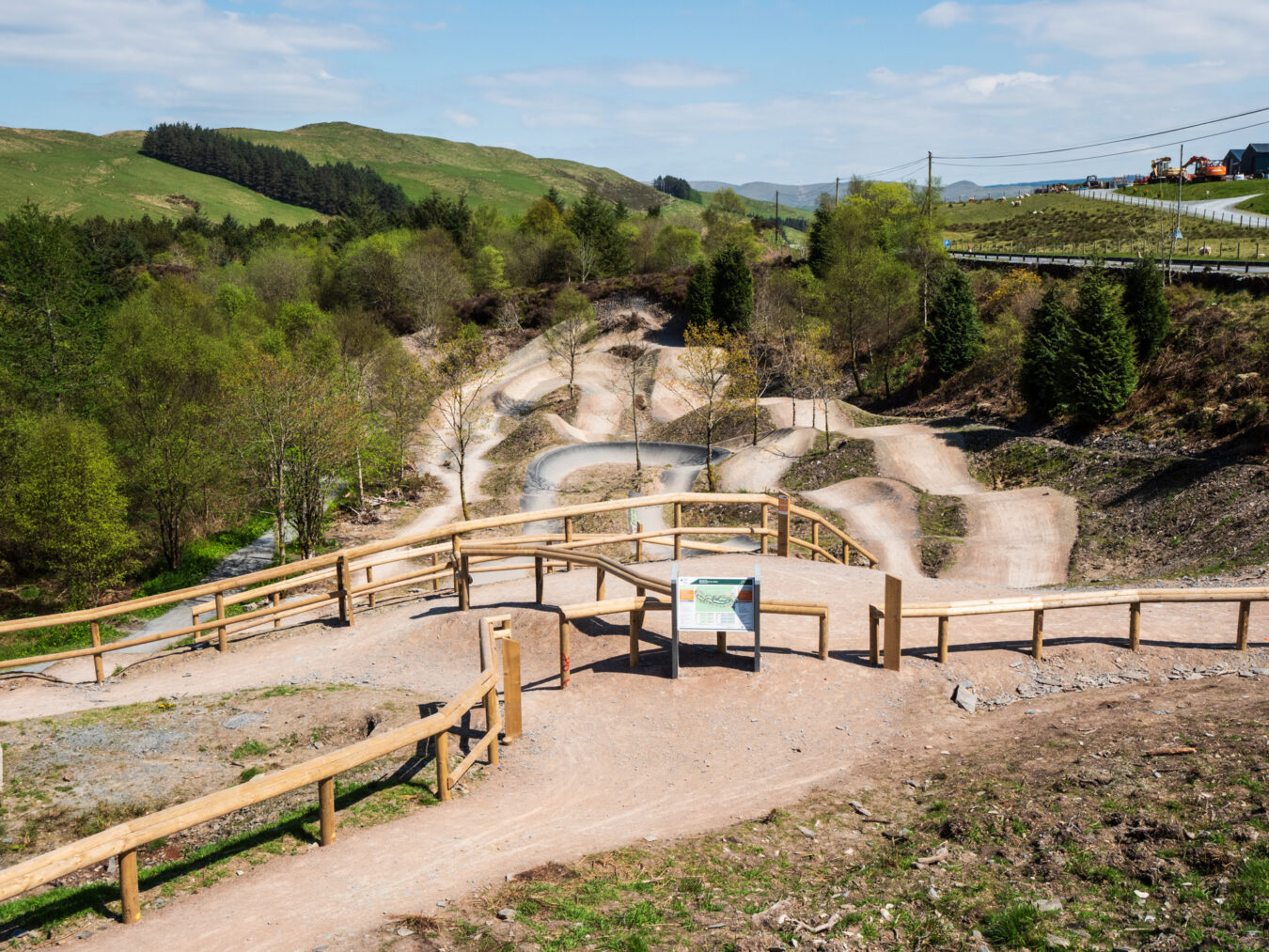

Unlike Gigrin, there is no entry fee; you just need to pay for parking when you arrive. The visitor centre includes a shop and a café that offers hot and cold meals. There are also two toilets on the site, one inside the visitor centre and one outside.
The best way to see the red kites is to go to the outdoor seating area in front of the lake, which is a few minutes’ walk from the visitor centre (follow the Barcud Trail; it’s very easy to get to).


A NOTE ABOUT THE VISITOR CENTRE
Valid until March 31st, 2025
Beware that on more than one occasion, I have found the café and visitor centre unexpectedly closed due to a shortage of staff, technical issues, or maintenance. The park remains open, and you can still see the red kite feeding, walk, or ride the trails, but without the option of a hot drink or light snack. At other times, Wi-Fi problems have meant staff could only accept cash.
The best way to ensure everything is running smoothly is to check the Bwlch Nant Yr Arian Facebook page in the morning. They update it regularly with information and important announcements, including when some of the trails are closed to the public. This way, you’re unlikely to arrive on an empty stomach only to find out there is no food available or that you don’t have cash with you.
There is an electric car charging point, although it is sometimes out of order. Again, check the Facebook page or the official Natural Resources Wales website for the latest information.
In case of extreme weather (snow, ice, strong wind), facilities including the visitor centre and car park may be closed. The Facebook page is the best place to get short notice information.
What you will see at Bwlch Nant Yr Arian
Around 150 kites come to feed, but their numbers will grow in the colder months. They are mostly local birds, coming from an average radius of up to 10 miles. Ducks will eventually take advantage of the situation and step onto the feeding ground. Some seagulls will wait for pieces of meat to fall into the water. You may also spot Canada Geese in the winter and, if you’re lucky, a grey heron may patiently wait in the background by the trees before joining the feed mid-course. I’ve also seen a cormorant a few times, resting on a log in the water, although it didn’t grab any meat.






The Photographers’ Corner
If you walk around the small lake following the Barcud Trail, you can reach a photographic hide opposite the outdoor seating area, which allows you to be very close to the field where the food is laid out. However, visibility is quite limited due to some trees obstructing the view. It’s difficult to follow the kites from the sky to the moment they dive in. While it’s a good spot to observe them up close, it is less suitable for photography, and I personally avoid it.

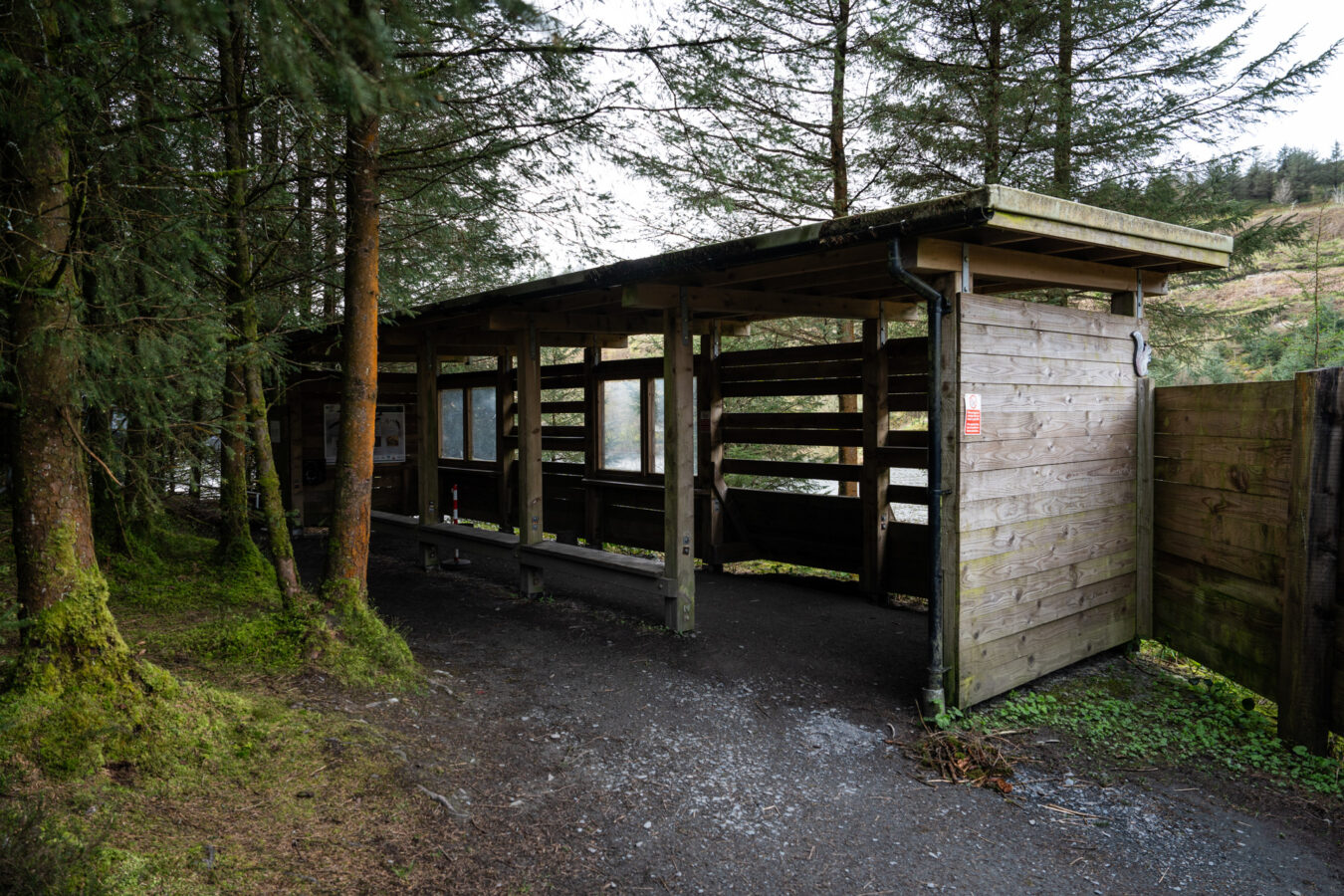

Instead, I recommend positioning yourself on the other side, in front of the seating area. Beware that during the holidays, the place can fill up quickly. If you want to secure a spot in the front row, aim to arrive at least 20-30 minutes earlier.

The advantage of this location is the lake. The member of staff who puts the meat on the ground often throws a few pieces into the water, providing photographers with a great opportunity to capture low-ground shots of red kites grabbing food from the lake.




You’ll need a longer telephoto lens than at Gigrin, ideally around 600mm, to ensure you can fill the frame adequately. The sun shines from the right, and many trees in the background will be in shadow, which can challenge your camera’s metering. You may need to adjust the exposure compensation if the kites appear too bright in your photos.




IN A NUTSHELL
Bwlch nant Yr Arian
Where is it? Ponterwyd, Aberystwyth, SY23 3AB (see it on Google Maps | Apple Maps | what3words)
What are the opening hours? The park is always open. The shop and visitor centre are open daily from 11am to 4pm. The café closes one hour earlier, at 3pm.
Can I visit any day? Yes, the park is always accessible, and the visitor centre is open 7 days a week, except on Christmas Day, Boxing Day, and New Year’s Day. However, there may be days when it is unexpectedly closed. Check the Facebook page for late notice information before you go.
What time are the kites fed? 2pm in the winter and 3pm in the summer.
Do I need to pay? There are no entry fees; you only need to pay for parking (£1.50 per hour or £5 for the day). Please be aware that only one machine accepts card payments, and neither of the two machines provides change.
Where can I park my car? There is a car park available on site, which includes one charging station for electric cars. The car park is spacious, but during the peak summer season, I recommend arriving a bit early. Check the Facebook page or the Natural Resources Wales website to see if the charging station for your electric car is operational, as it is sometimes out of order.
Can I get there with public transport? The X47 bus from Aberystwyth to Llanidloes can stop at the visitor centre on request. For more information and a timetable, check the Traveline Cymru website.
What amenities will I find on the site? The site features a café, shop, and visitor centre, as well as picnic tables, two toilets, two playground areas, mountain bike trails, horse riding trails, and walking trails.
Can I bring my dog? Yes, but please keep them on a leash during the kite feeding time. On one occasion, the feed was delayed because a small white dog ran off to the feeding ground, scaring the kites and annoying visitors. Free dog waste bags and refuse bins are provided.
What about accessibility? There is parking for Blue Badge holders, accessible toilets, courtesy wheelchairs, and facilities for the hearing impaired inside the café. The visitor centre, café, and the Barcud Trail around the lake are suitable for wheelchairs.
Llanddeusant Red Kite Feeding Centre
The third location is found in the western part of the Brecon Beacons National Park, making it the closest if you are stationed in South Wales. It is the most remote of the three locations, accessible via narrow B roads, which in my opinion, adds to its distinct character. You are completely immersed in the dramatic Welsh countryside, far from any urban centres.

The Llanddeusant Feeding Centre is also the smallest. You won’t find any shops or refreshments, and there are no toilets. There is a small entry fee, but they only accept cash. During school holidays, it is advisable to arrive one hour before feeding time, as there is limited space in the hides. Despite being remote, the station is very popular and fills up quickly. You can’t book, so it operates on a first-come, first-served basis.
There are two parking areas, but these are separate from the entrance to the hides, which can be confusing depending on where you are coming from. You might see the entrance to the station before finding the parking area when you travel from the west.

If you use GPS navigation, it is best to set the car park as the destination (see map links below in the “in a nutshell” section). You will see a sign for the car park and directions for the hides once you have parked, but the signs are small and not very noticeable from the road.



The two car parks are located at a road intersection, just next to a series of cottages. After parking, take the road adjacent to the yellow Red Kite cottage, following the road sign for Myddfai. Once past the cottage, you will see a private gate further on your left. Keep walking for a few minutes until you see the Red Kite Feeding Centre on your right. One hour before the feeding, the door will be open and a person will greet you and direct you inside.




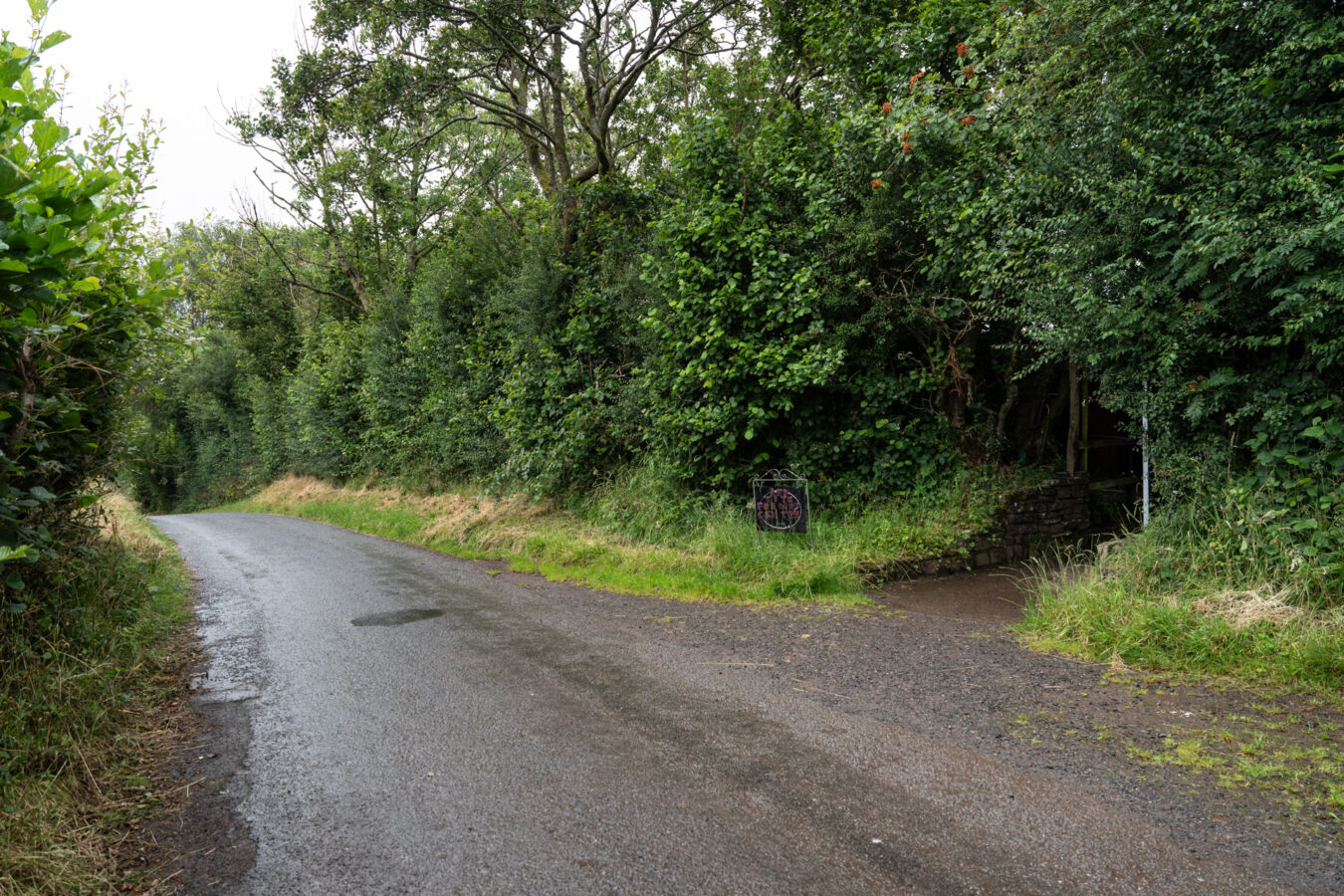
The farmer may take the payment immediately or after he has prepared the food near the field. There is also an honesty box inside the hide in case he hasn’t collected money from everyone. There is a lot of interesting information you can read inside the hides while you wait for the feeding to start.


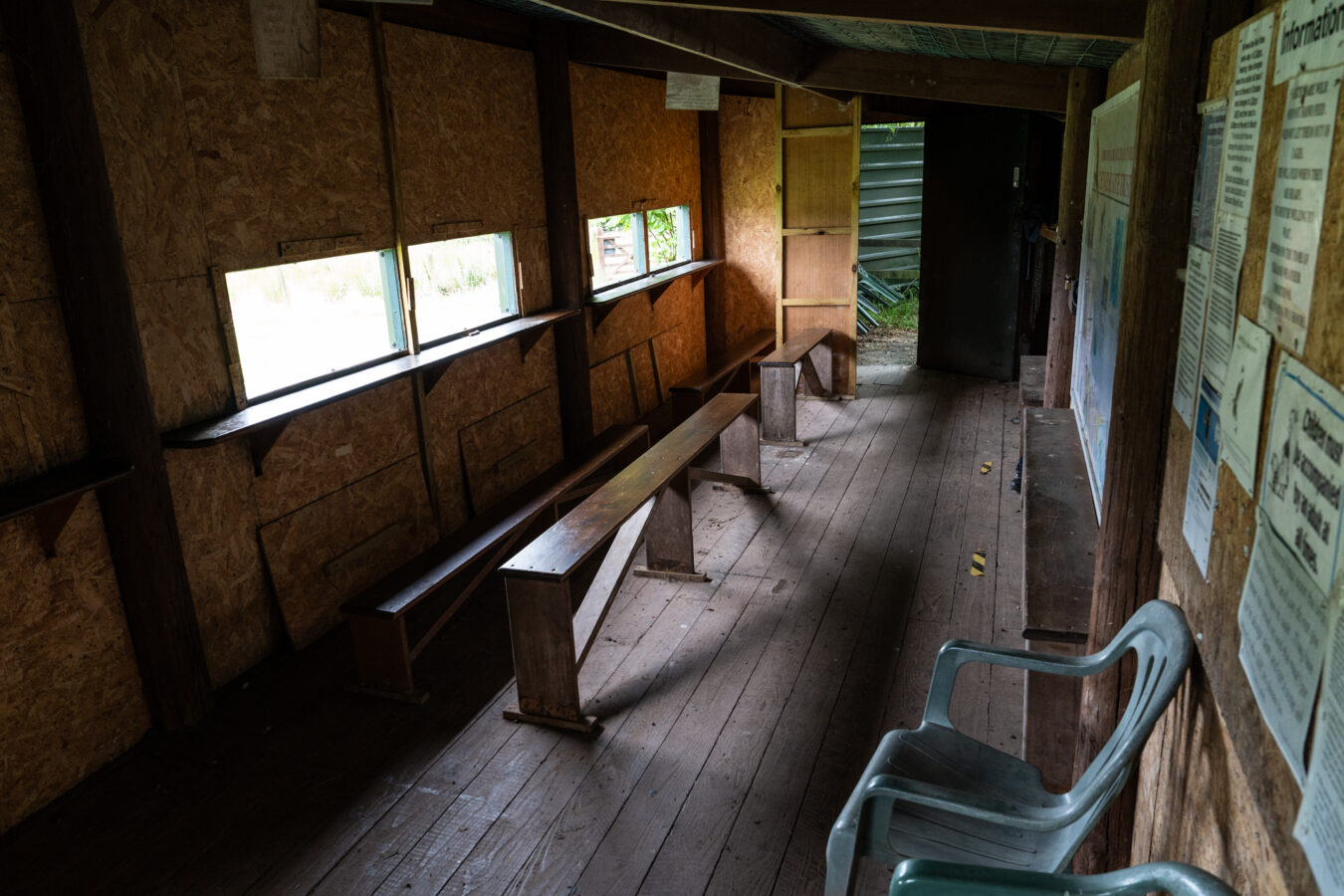

What you will see at Llanddeusant
Hundreds of kites will join and fight for food alongside crows and ravens. There are also magpies that go for a piece of meat when the kites take a break.



Llanddeusant for Photographers
The field is much smaller than at Gigrin and Bwlch Nant Yr Arian, and you are also very close to the action. I used my 300mm lens (full frame) and found it to be just about the perfect length for the kites. However, you may want a longer reach for capturing the many crows and magpies that join the feast.

The kites never stop on the field, unlike at Gigrin for example, and from the hide, you don’t have a wide view of the sky above, so you have to be really quick in capturing the birds as they dive to the ground.


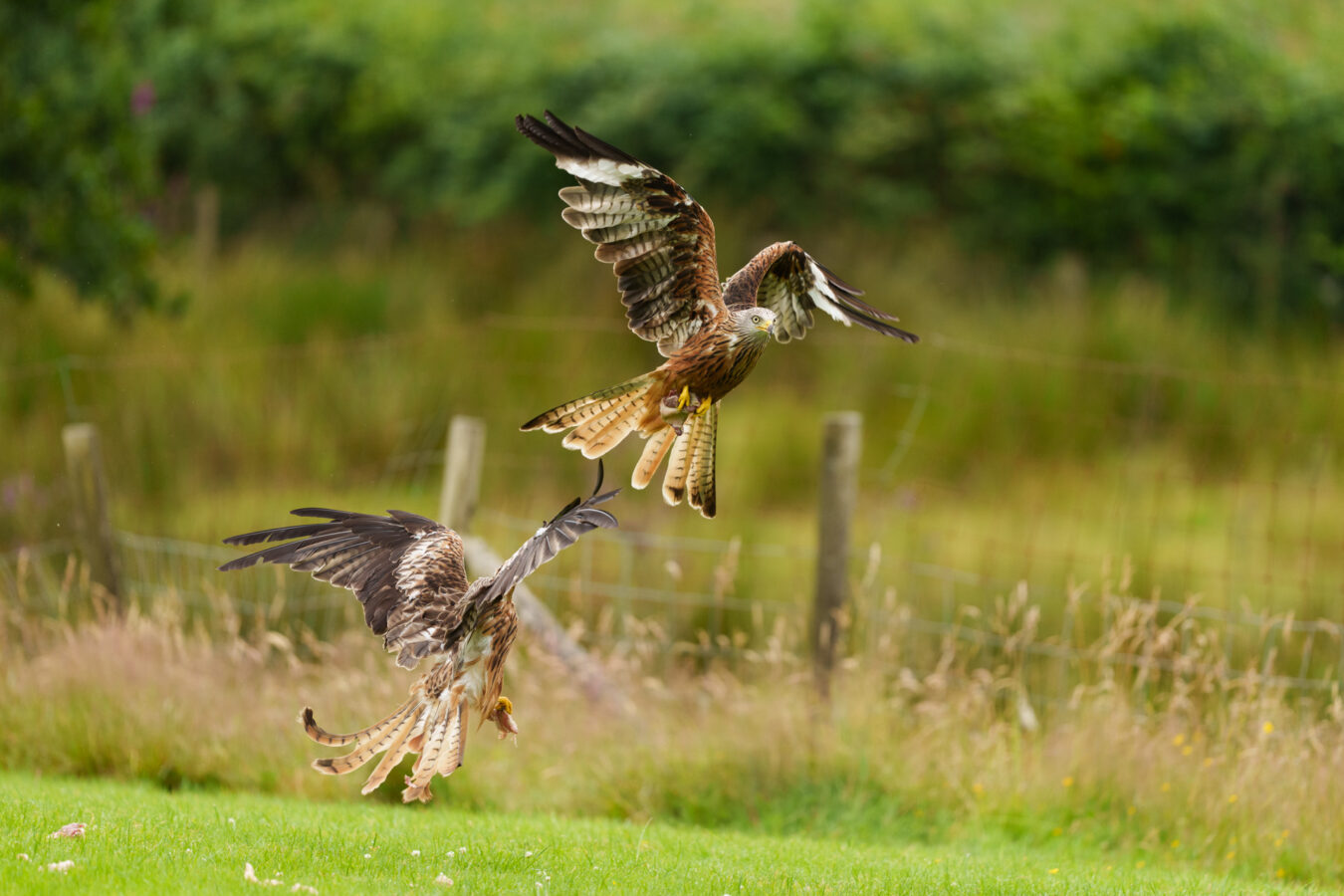



IN A NUTSHELL
Llanddeusant Red Kite Feeding Station
Where is it? Llanddeusant, Llangadog, Carmarthenshire, SA19 9YG (see it on Google Maps | Apple Maps – what3words – note that these links take you to the two car parks)
When can I visit? The feeding station is open Thursday to Sunday during school terms, and every day during school holidays. It is closed in January and early February. Arrive one hour before the feeding starts, as spaces are limited and can fill up quickly.
What time are the kites fed? 2pm in the winter and 3pm in the summer.
Do I need to pay? Yes, there is a small fee of £6 (£5 concession and £3 for children). Note that it is cash only.
Where can I park my car? There are two car parks about 245 yards from the hides, at a road intersection with a few cottages nearby. They are not very large, so it’s advisable to arrive early.
Can I get there with public transport? The feeding station is on a narrow B road that no buses will go through.
What amenities will I find on the site? Only the hides. There are no toilets, shops, or refreshments.
Can I bring my dog? Yes, but it must be kept on a lead at all times.
What about accessibility? The hide can be accessed with a wheelchair, and there are wide access points inside.
Which Red Kite Feeding Station Should I Visit in Wales?
Each location has its list of advantages, and none of them will disappoint when it comes to the main attraction, the red kites. So it really comes down to preferences and the travelling distance.
Gigrin offers the best variety when it comes to hides, including speciality hides designed for photographers (they even offer a photography workshop on select dates). The farm is easy to get to and includes all the amenities you’d want, such as a coffee shop and toilets. It is the most expensive, but don’t forget it’s run by a private farm, so in my opinion, it is justified.
Bwlch Nant Yr Arian is also easy to access and less expensive, as you only need to pay for parking. It’s a great location for a family day out because of the extra activities you can do, from hiking to mountain biking. The visitor centre and kids’ playgrounds mean there is something for everyone. The lake also provides a better variety of pictures for photographers.
Llanddeusant is a smaller, more intimate location. You are deep in the Welsh countryside, and you are very close to the kites and feeding action. There are no amenities, but the spectacle is no less impressive.
Extra Information
Weather
The weather always vary in Wales, no matter the season. I’ve taken pictures in perfect sunshine and blue sky, as well as cloudy, rainy, windy and snowy days. I usually check the forecast on the MET Office website to get an idea on what to expect.
Red Kites will be less active when it rains hard, so if you see the forecast predictions heavy rain all day, it’s not worth going. However, variable conditions can still give you opportunities. I remember my first visit to Gigrin was met with a mix of rain and sun. The kites perched on a tree when it was pouring, only to resume as soon as the rain stopped, which contributed to a great experience to witness and photograph. Likewise, my first visit in Llanddeusant was on a cloudy, drizzling day with the occasional light shower, but the kites still came and fed.




Strong wind can be annoying for photographers if you don’t shelter in a hide, and that is particularly true for Bwlch Nant Yr Arian where the only hide available doesn’t offer a great view.
Unpredictability
I’ve been photographing red kites at the feeding stations for the past 8 years, and rarely I’ve been met with disappointment. That said, remember that red kites are 100% wild animals and as such, there might be the odd day where they turn up late for food, or wait one hour before coming down to grab the meat. This is more likely to happen during bad weather, if there is a higher number of spectators than usual, or if dogs are let loose (please keep them on a leash at all times).
If they are late, you just need to be patient. They never leave food on the field.
What happens during the feeding
Usually, crows will start to gather near lunchtime, alerting the kites that the food has arrived. In the summer, the kites may wait for the crows to grab some meat only to chase them and steal it!

It may look like the kites are missing their target on the ground more than once, but their intention is to make the crows fly into the air, from where the more agile kites will try and steal the meat. However, the crows can fight back, causing the kites to drop the food, which will then be picked up by another kite. Red kites will also fight amongst themselves. As a result of all the action, you may photograph moments when the kites lose the meat or try to catch it back. They may also lose some food simply because a piece of meat breaks.


Once a kite has some clear space, it will eat in the air, bringing its leg forward and turning its head down while flying. This is another golden opportunity for pictures.


Older kites will usually eat first, then the younger birds will follow and take turns. During the warm months, the feeding can go on for two or three hours. The kites are less hungry because they can find more food elsewhere, and because they can grab dead mice and worms when farmers’ tractors cut the fields.
During the winter, however, the red kites eat much quicker. They will try to feed all at the same time, which leads to more fights in the air, and the food can be gone in less than 10 minutes.



Photography Tips
Photographing red kites at the feeding stations is relatively easy, and these locations are excellent for learning their movements and behaviour. That said, they are quite fast in changing directions and flying down to grab the food, so it’s important to pick the right camera settings and be prepared.
If it is your first time, the best approach is to choose and follow one kite. It will circle in the sky for a few minutes before diving down, changing its body position and going head first. This will help you get a complete picture of the action and understand what is going on. If you aim at the ground where the meat is, you may find the action too fast and confusing to follow, and you might hesitate about which kite to focus on.

Another challenge for beginners is transitioning from observing with your eyes to looking through the viewfinder and taking pictures, as you may lose track of the bird if you are not quick enough. Keep your camera and lens as close to your eyes as possible, so that when you look through the viewfinder, the amount of movement is minimal.
As for your camera settings, these are the ones I use on a regular basis:
- Shutter Speed: Around 1/2000s or faster if it’s a bright sunny day.
- Aperture: The fastest available, depending on your lens. If you have a f/2.8 telephoto lens, keep in mind that kites can fly close to you, which may result in the closest wing being in focus while the head is out of focus.
- ISO: Auto, with a maximum of 6,400. You can adjust the maximum output depending on the quality of your camera sensor and your tolerance for noise.
- Autofocus: This really depends on your camera and its features, but generally, I prefer a medium to large focus area with continuous AF. If your camera’s AF is reliable, you can use the tracking mode (even better if it can automatically recognise birds). I also set Focus Priority in the menu, meaning the camera is less likely to take images if the bird is out of focus. Some photographers may prefer Release Priority to avoid missing shots. Knowing your camera’s performance will help you choose what works best for you.
- Drive: The action is quick, so select a fast frame rate if your camera offers this option (10fps, 20fps, or even more). Keep in mind that some cameras may not support continuous autofocus at the highest drive speeds. Check the user manual for specifics.
Can I see red kites somewhere else?
Feeding stations offer an optimal opportunity to see red kites in numbers and up close, while also ensuring safety for both you and the animals. I would discourage anyone from attempting to see kites in the wild unless you are a wildlife photographer with years of experience and know how to move around without disturbing the animals and nature around.
Even without visiting a feeding station, it’s not uncommon to spot a kite circling above a field in search of food. They are active all over the country, throughout the day and all year round. On one occasion, I even saw a kite flying over the road after it had just grabbed a small squirrel. However, the traffic scared it off, causing the kite to drop its prey on the tarmac. The squirrel survived and managed to escape.
Red Kites in Wales
The story of red kites in Wales is a symbol of remarkable conservation success. Once on the brink of extinction in the United Kingdom, with only a few breeding pairs remaining in Wales, planned efforts by volunteers and organisations have restored their numbers to what you can witness today.
In the Middle Ages, red kites were valued for their role in cleaning the streets and were even protected by royal decree. However, from the 16th century onwards, they were increasingly labelled as vermin and wrongly accused of killing livestock. This led to hunting, illegal poisoning, egg collecting, and taxidermy, driving red kites to extinction in England and Scotland by the end of the 19th century. Only a handful of pairs survived in Wales, in rural woodlands with minimal human activity.
Efforts to preserve the red kites began in the early 20th century but faced challenges due to low reproductive rates, poor habitat conditions, and the impact of rabbit myxomatosis in the 1950s. However, with more concerted efforts from volunteers and later support from the RSPB, red kites were designated as a protected species, and their numbers began to recover in the 1980s.
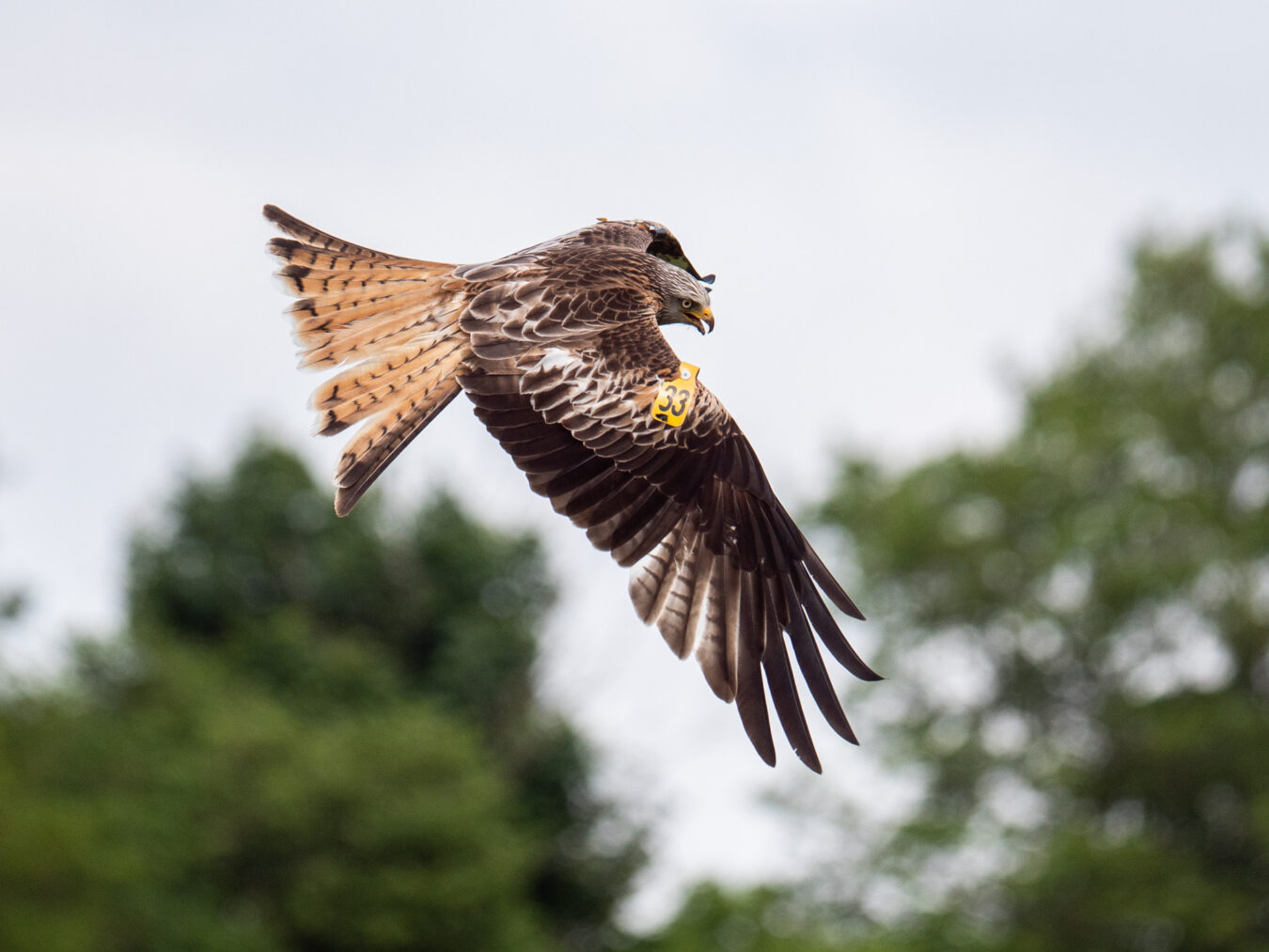
The Welsh Kite Trust, founded in 1996, has been instrumental in ensuring the survival of these magnificent birds of prey across the country. The red kites have also been reintroduced to England and Scotland. In Wales, their numbers have surged from around 20 breeding pairs in the 1960s to more than 2,500 in 2019. DNA analysis later revealed that the entire Welsh population of red kites is descended from a single female bird.
Feeding stations have played a crucial role not only in providing food but also in raising awareness in a protected environment. They help discourage people from seeking out red kites in the countryside, which might disturb their nests or damage their eggs.
quick facts about THE RED KITES
Red kites are part of the Accipitridae family, which includes hawks and eagles.
They measure between 60 cm and 66 cm in length and weigh between 800g and 1,300g. Their wingspan ranges from 175 cm to 195 cm.
Primarily, they feed on carrion and worms but will also take the opportunity to consume small mammals such as voles and mice, as well as small birds.
Red kite nests are typically situated high in trees, around 12 to 20 metres above the ground. These nests are maintained and renovated throughout the breeding season and can be reused in subsequent years.
A few days before laying their eggs, red kites often incorporate shiny and colourful objects into their nests.
They are monogamous, meaning they mate with the same partner each season, and generally lay an average of three eggs.
The chicks remain in the nest for about 60 days, with their parents continuing to feed them for a few weeks after they fledge.
Red kites nest in broadleaved woodlands but will search for food in wooded valleys, open countryside, and even suburban areas.

